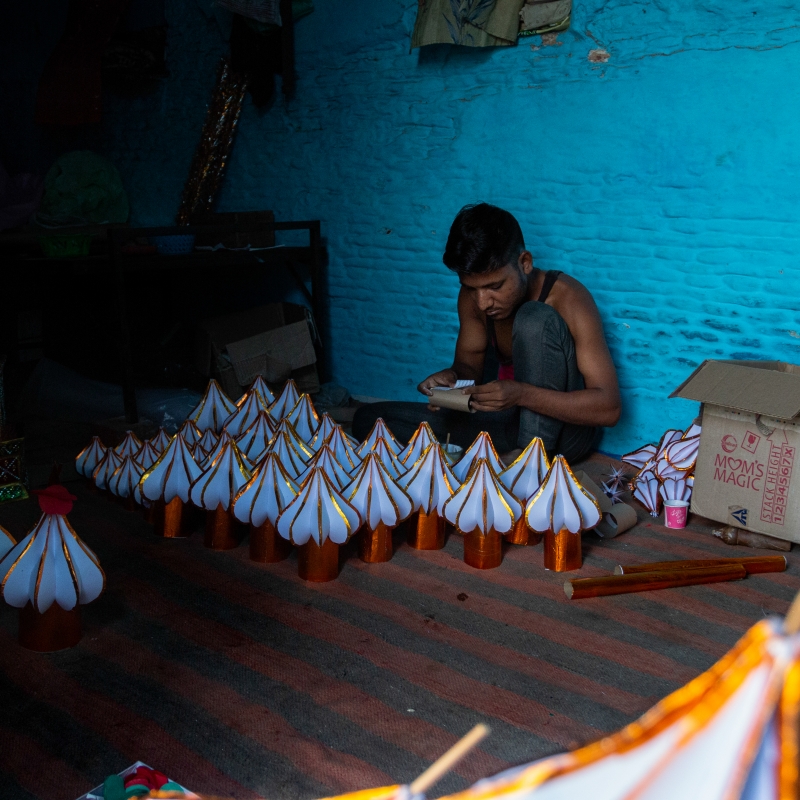An important part of the Muharram celebrations of Muslims as well as non-Muslims, taziya, (Fig. 1) made in numerous forms and types, is a replica of the mausoleum of Imam Hussain (a.s.), the grandson of Prophet Muhammad (p.b.u.h). Taziya can be brought home on any day between the eve of the first day of Muharram and the ninth day and buried on the tenth day known as Ashoora, when Imam Hussain (a.s.) was martyred in AD 680 along with over 100 of his companions in the battle of Karbala fought against the army of Yazid, the then ruler of Syria.[1]
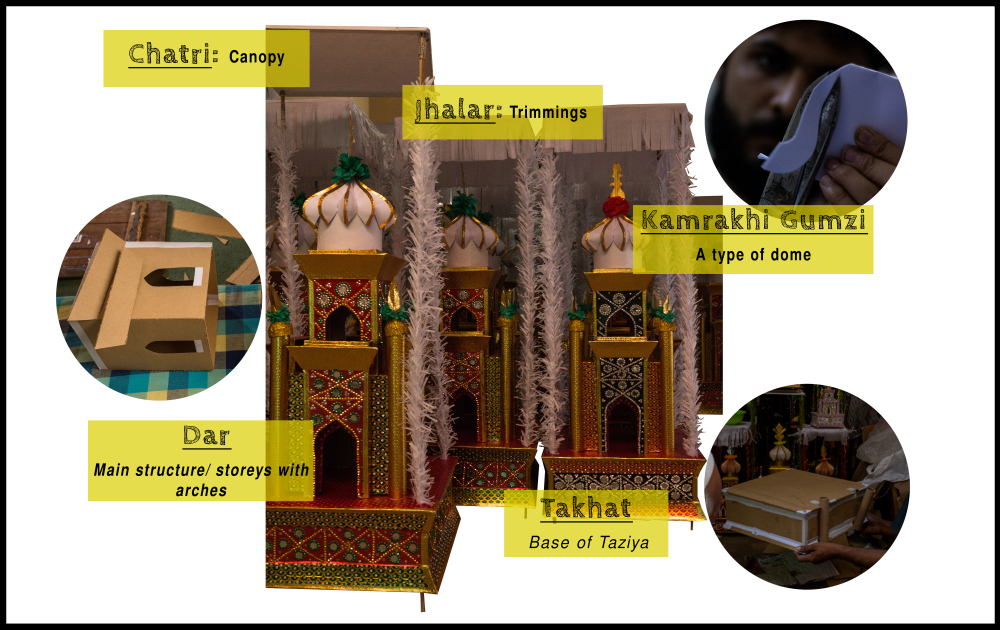
Taziya is brought with immense care by both men and women, and children accompany them with great enthusiasm. It is placed inside the azakhana ((a private, temporary imambada), a temporary space created for Muharram, which is already aesthetically assembled with flowers and itr (perfume) and people perform matam (gentle beating of the chest and head to mourn the tragedy of Karbala) with chants of ‘Ya Hussain’. Taziya adds life to the azakhana and its arrival is a sign of commencement of mourning. All the other elements of the azakhana are permanent structures which are reused with occasional repairs and changes.
The word taziya comes from the Arabic word aza which translates to commemorating the dead; thus, taziyat means paying condolences, homage and respect to the deceased.[2] In a sense, taziya is a symbol around which the practice of azadari (mourning rituals and cultural depiction of the tragedy of Karbala) in Muharram revolves. Azadari symbolises respect for the martyrs of Karbala who were not buried after being killed on the battlefield, and includes majalis (a gathering of mourners with organised sermons/lectures on the tragedy of Karbala and Islam), matam (Gentle beating of the chest to mourn the tragedy of Karbala), processions, alam (a flag which is a symbol of Hazrat Abbas, Imam Hussain [a.s.]’s younger brother and also the commander in chief of Hussain’s army in the battle of Karbala), sabeel (a stall where tabarruk [food and water] is kept served for travellers, mourners, and visitors), fatiha (first chapter of Quran, recited for the deceased along with offerings), food distribution, prayers and various other acts of mourning. (Figs 2, 3, 4 and 5)
![Fig. 2: A maulana (religious preacher) addressing a majilis inside an imambada in Amroha a night before Chehlum (fortieth day after Ashoora; it commemorates the visit of surviving members of Prophet’s family to the grave of Imam Hussain [a.s])](http://www.sahapedia.org/sites/default/files/styles/sp_inline_images/public/inline-images/Fig%2005.jpg?itok=q86wzVAU)
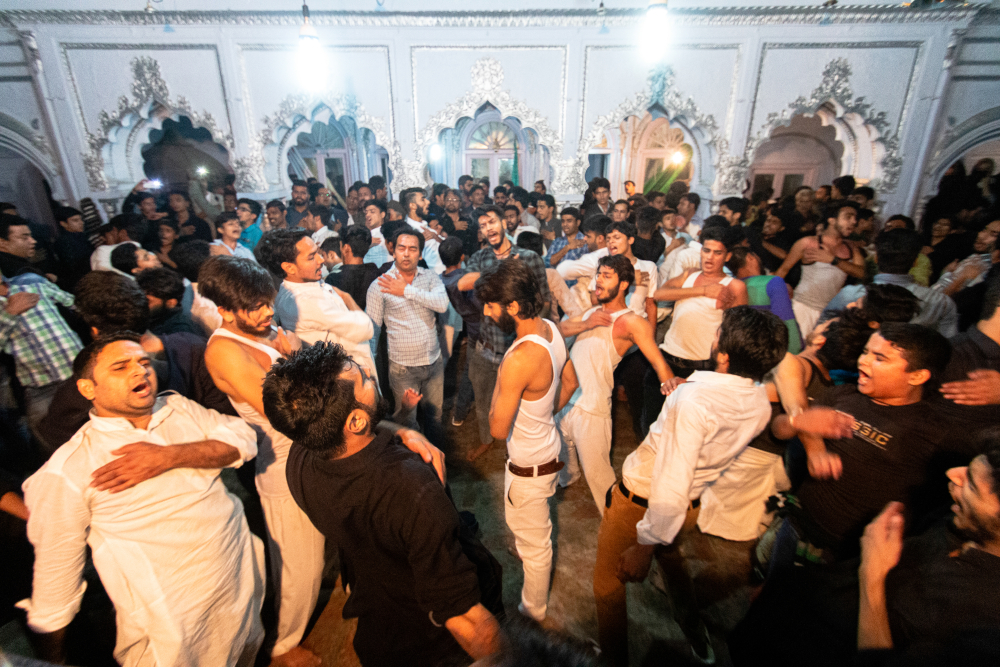
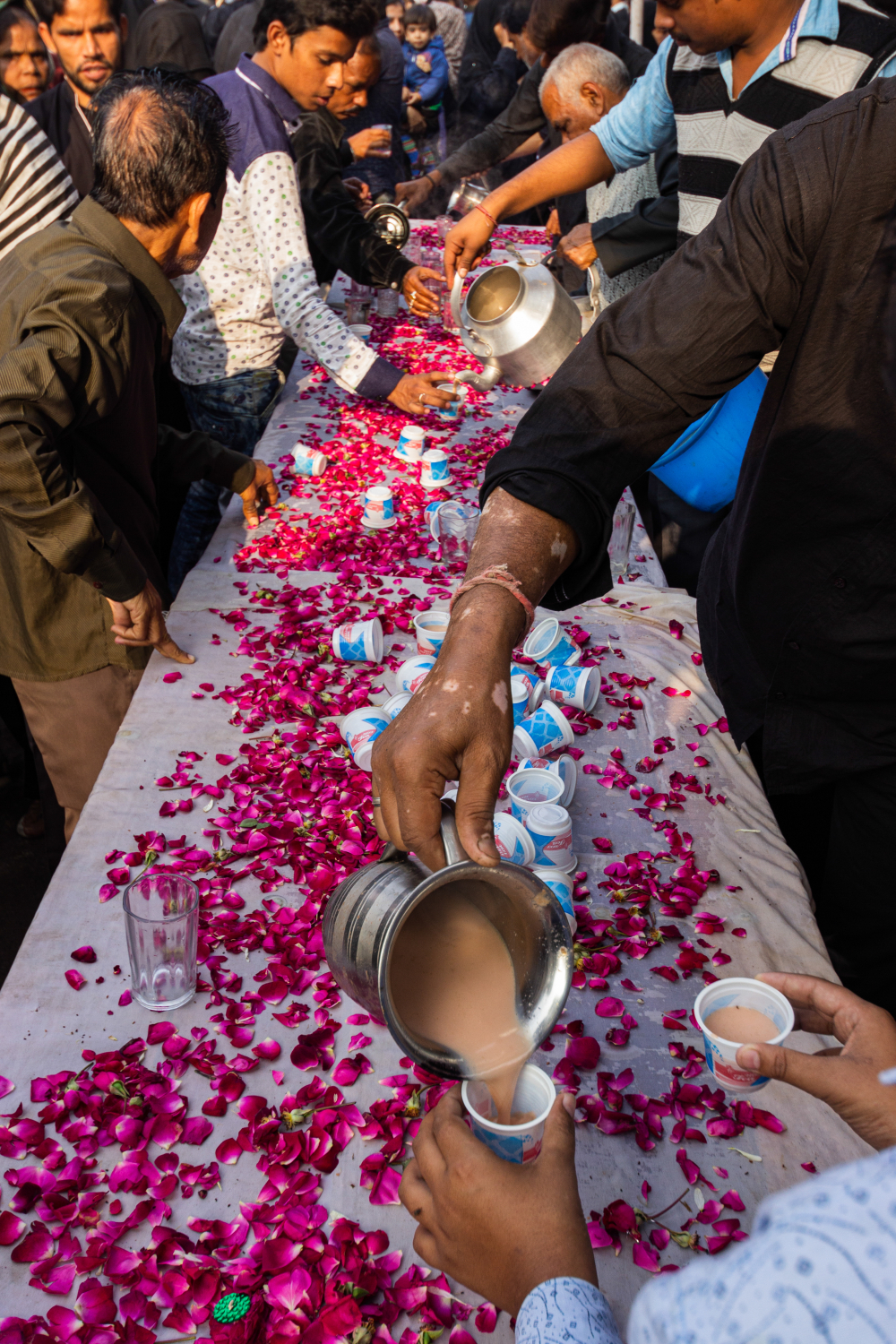
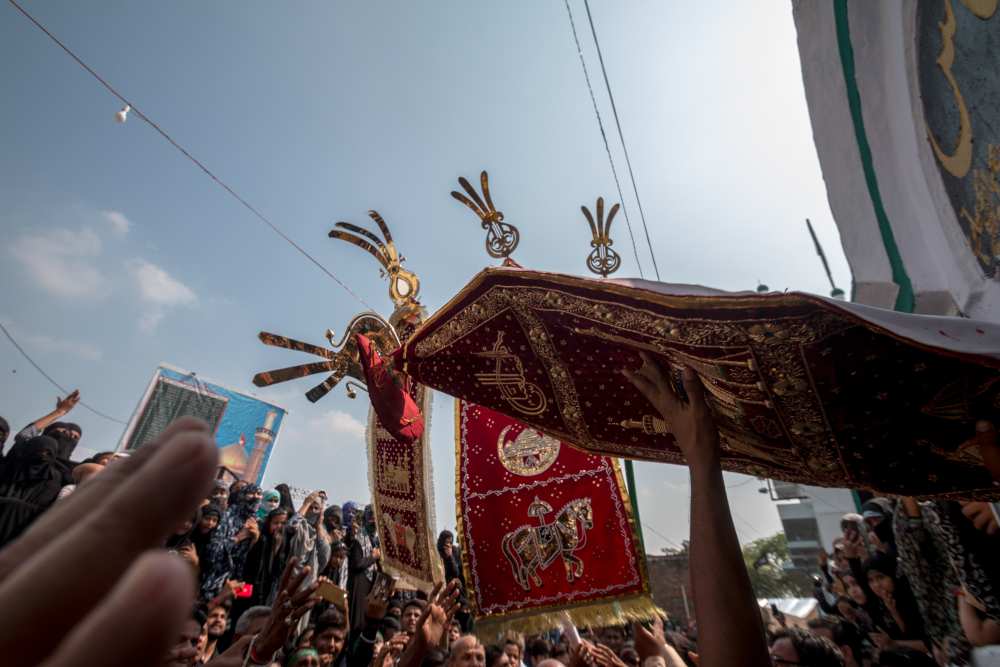
During Muharram, while women perform mourning rituals in an azakhana (Fig. 6), men practice Muharram outside in processions and in imambade (plural of imambada). Taziya, alam and other Muharram symbols are aesthetically assembled in both azakhane and imambade, which unlike an azakhana is a permanent structure. Taziya is the most dominant symbol associated with Muharram. Against popular belief, Muharram is not simply a one-day observance, but is observed for a month by the followers. Taziya plays a significant role in imparting knowledge through generations as it is passed on through visual and oral traditions, along with its associated traditions. The daily mourning practice of matam, majalis and nauhay (lament about the martyrs of the Karbala tragedy and other family members of Prophet Muhammad [p.b.u.h]) revolves around taziya which are led by senior women and children of mohallas (community area). It is here that young girls practice their skills of recitations of nauhay, majalis and soz salaam (an elegy for martyrs of Karbala tragedy). Children accompany in all practices and their association to taziya starts from a very young age. The journeys of taziya from the market to the house and from the house to the karbala (burial grounds named after the battlefield) are led by young children. It is here they learn the sacredness of this structure and rituals associated with it. Taziya is relevant both socially and as a symbol of religiosity, and also remains an economic commodity as the structure that becomes the taziya is worked upon in detail and sold in the market by the maker. The art of the taziya remains intact in its transcendence from a saleable craft to a symbol of faith. However, in the process of a taziya living its holy life, the importance of its maker’s livelihood and his intricate art gets overshadowed. They remain unsung heroes because the holiness of the taziya dominates and people fail to acknowledge the artist’s skill.
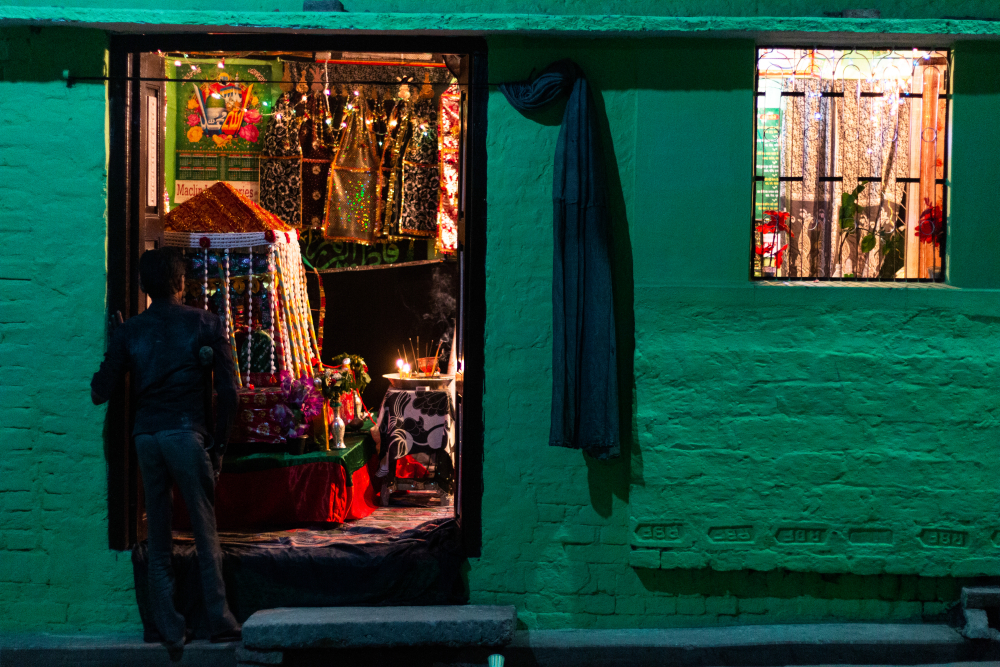
Many Meanings of Taziya
While taziya literally means homage or condolence, generally it is also used for the mausoleum replica of Imam Hussain (a.s.) apart from being used interchangeably to mean zarih (an elevated structure that surrounds a grave and gives it its identity)
In Sunni tradition, the term taziya is popular, whereas in Shia tradition, both taziya and zarih are used for the mausoleum. Taziya and zarih are similar in structure and are made using the same techniques. Generally, while the taziya sits on a rectangular takhat (base of taziya), a square base is used for zarih. The karigar (craftsman) uses his skills and imagination to make taziya and zarih and ensures a perceptible difference between the two in their unique ways. Apart from the shape of the base, the basic differences between the two are that zarih has more round-shaped domes whereas taziya has more conical domes, and the pillars that act as symbolic alam in zarih are erected outside the dar (the main structure of the taizya that sits on the base). Overall, embellishment is more ornate in zarih, but all this depends on the maker and their knowledge. Usually, the larger zarih is kept alongside the smaller taziya. All imambade have a permanent zarih (Fig. 7) made of varied materials, some are also accompanied by a permanent rauza (shrine) (Fig. 8); however, there are no permanent taziye as a taziya is always a temporary structure brought in for the duration of Muharram and buried later.
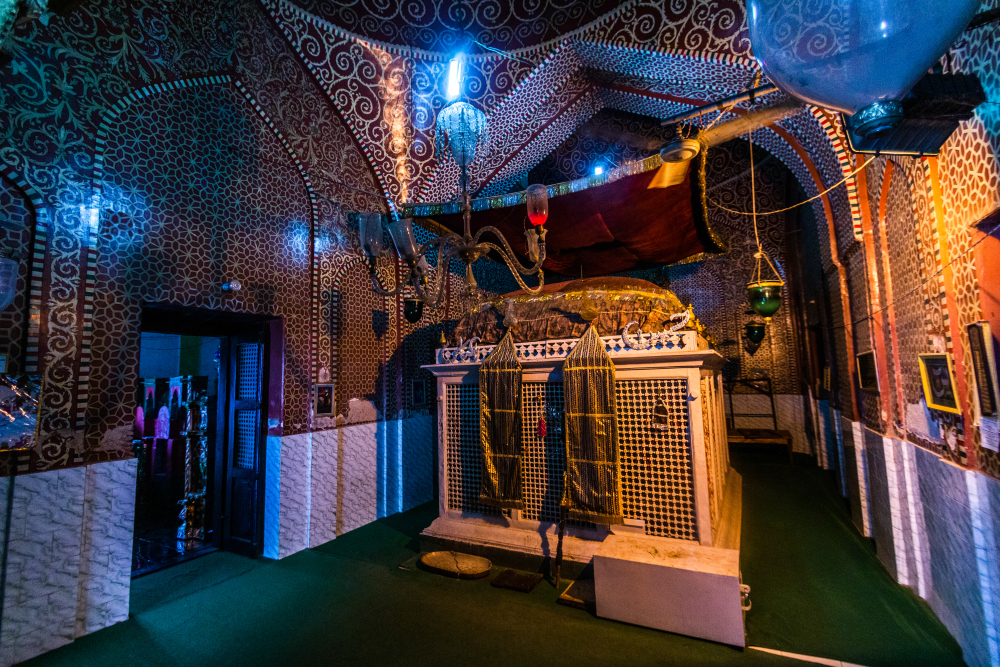
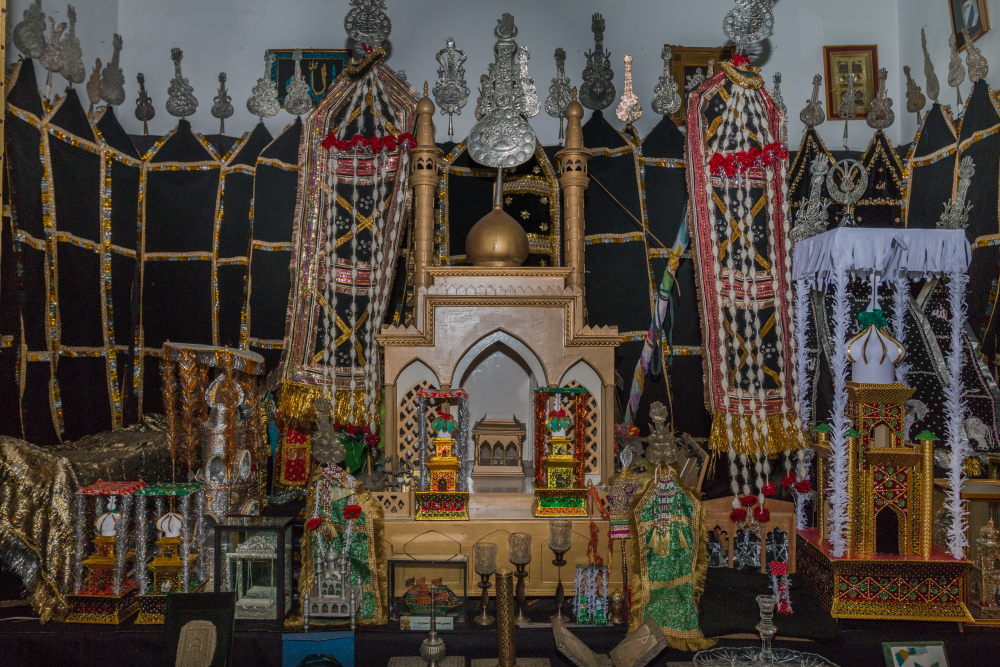
In Lucknow, a palm-sized taziya, known as mannati (prayer) taziya, and zarih are brought in along with a larger taziya and zarih to keep for prayers during Muharram. (Fig. 9) Mannati taziye are made of cigarette boxes and coloured papers; the miniature zarih is kept for girls while mannati taziya is kept for boys.

While the taziya is made in all colours, they are traditionally in green and red. Green is associated with Imam Hasan (a.s.) and red with Imam Hussain (a.s.).[3] Imam Hasan (a.s.), who was the elder brother of Imam Hussain (a.s.) and second Shia Imam, was poisoned a decade before the event of Karbala on day 28 of Safar (the second month in the Islamic calendar; Muharram along with Safar makes up two months of the mourning period known as Ayyam e Aza). Imam Hasan’s (a.s.) death anniversary falls in the mourning period, which is two months and eight days, popularised in the mid-nineteenth century in Awadh.[4]
The whole act of bringing taziya home, keeping it in reverence for a few days and then dismantling it ritually is called taziyadari. The term taziyadari is more generally used in Sunni Muslim traditions. Mourning rituals like matam, alam and sabeel are also part of Sunni traditions, but taziyadari is the term that is generally used to define any mourning practice.
The Contested History of Taziya and Taimur
It is believed that Mongol ruler Taimur, also known as Tamerlane, started the trend of taziya at the end of the fourteenth century. It is said that when Taimur was on a conquest in India, he used a replica of Imam Hussain's (a.s.) mausoleum given to him in Karbala by a Sayed Aalim (Syed Aalim is not a name but a title. Syed are people whose lineage can be traced back all the way to Prophet Muhammad and Aalim means a learned person) and asked his men to use it to mourn Hussain's martyrdom.[5] It is believed that he put the replica on an elevated platform and paraded it across the camp. The practice soon became popular and people began making replicas of the mausoleum with varying crafts and skills to observe Muharram.
Historians present Taimur as a follower of Imam Ali (a.s.) and Imam Hussain (a.s.). Taziya and Taimur seem to go hand in hand. There are various versions in popular history from regarding Taimur as the flag bearer of Taziya to remembering him as one who turned into a believer after suppressing the practice; however, these stories are absent from recorded history. ‘Call it our inadequate knowledge or anything, we confess that so far we have failed to discover the authentic origin of this practice (Taziya) in the annals of history pertaining to the times of King Taimur,’ writes scholar and thinker Qibla Ali Naqi Naqvi.[6]
While some historians say that the site of Taimur’s parading of taziya was his camp in Delhi,[7] there are others who disagree with this theory. Dr Roshan Taqui, a historian at Lucknow University, argues that Taimur did not introduce the taziya in Delhi. It happened that Taimur was returning from Delhi and going elsewhere in South Asia when one of his advisors suggested he replicate Imam Hussain's (a.s.) tomb; Taimur’s taziya parade thus happened somewhere else in South Asia and the taziya procession in India was first polularised during Humayun’s reign. [8]
Interestingly, the Dutch traveller Francisco Palsaert in the early seventeenth century writes about a taboot (a replica of the coffin, but it is not as represented in design and art as taziya or zarih) procession.[9] (Fig. 10) Poet and writer Shahid Naqvi in his book Azadari: Culture of Mourning mentions the word taziya when quoting Palsaert but he also mentions taboot when quoting Mohammad Bin Ameer Wali (1635–36) in Lahore and Aurangzeb in 1669 in Burhanpur, and writes about the popularity of taziyadari in later Mughal period of Mohammad Shah and his wife.[10] In historical records, different writers and travellers, especially Western writers, have used words like tomb, taziya, cenotaph, taboot while describing Muharram processions.
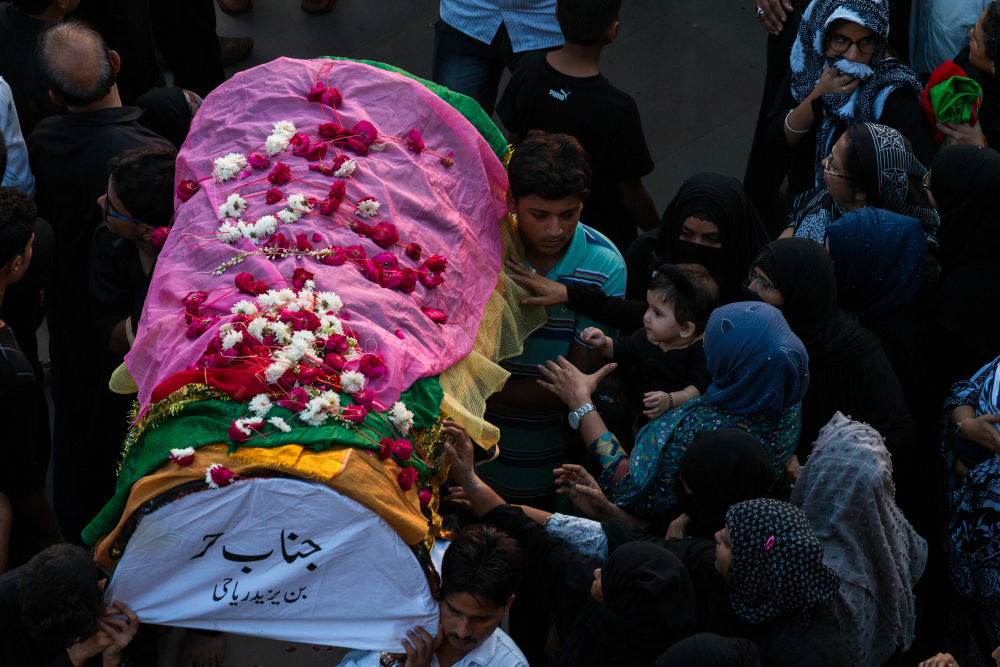
Taimur is often believed to be a Shia Muslim, which seems possible to some extent, especially given the taziya practice and his alleged tombstone showing the genealogy to first Shia Imam, Imam Ali (a.s.).[11] However, this veneration to the house of the Prophet (p.b.u.h) isn’t still clear evidence of Taimur being a Shia. He came from a Sunni Muslim area and his theological and religious guide was Hanafi scholar Abd-Al-Jabbar Khwarazmi, and his attacks against Shiite rulers were often on the pretext of Sunnism.[12] Taimur’s reverence for Imam Ali (a.s.) and Imam Hussain (a.s.) could be attributed to an aspiration for glory and valour in battles. Taimur’s army consisted of Shia Muslims as well,[13] and he at times saw himself as an eastern Alexander of the descent of Imam Ali (a.s.) and Fatima Zahra (a.s.), parents of Imam Hussain (a.s.). However, he also saw himself as Rustam (a legendary hero in Persian mythology) while defeating the hosts of Turan.[14]
American historian Beatrice Forbes Manz in his book The Rise and Rule of Tamerlane writes about Taimur as an opportunist who used religion to further his power: ‘In religion as in other aspects of his life and his conquest was above all an opportunist, his religion served frequently to further his claims.’ [15] Taimur’s campaign in India was quick, full of blood and destruction, such that to imagine something like taziya in this picture seems to represent spurious editing.
However, history never fails to surprise us. In 1393, Taimur, after his Baghdad conquest, visited Karbala to pay respect to Imam Hussain (a.s.) where he acquired the scarf of Fatima Zahra (a.s.) from the grave of Hurr Ibn Riyahi. Historians say that Imam Hussain (a.s.) gave this scarf to Hurr Ibn Riyahi[16], who was a fine warrior and one of the martyred soldiers in Karbala. This could be why he is deemed to be the descendant of Ali and Fatima.
Another story that links Taimur and taziya comes from an imambada next to the Nizamuddin Dargah in Delhi, which claims to have the taziya from the time of Taimur. The taziya at the dargah is still in use, and each Muharram on the day of Ashoora it makes its journey from Nizamuddin to Shah-e-Mardan where the turbat (miniature grave) is buried, and the taziya is brought back and kept in a locked room to be opened the next Muharram. Interestingly, some Sufis view taziya to hail from the pre-Taimur period. According to Dr Raziuddin Aquil of Delhi University, there is no evidence and he dates the emergence of taziya in India to the early Mughal period.[17]
Taziya’s Popularity in India
The taziya may have been introduced somewhere outside Delhi by Taimur or by soldiers in his army, and moved into India with Mughals, and was established in India with the nawabs of Awadh who helped popularise the practice. The clearest depiction of taziya is seen in the time of Nawab Asif-ud-Daula; it is said that the nawab and his advisors would visit common people’s houses to pay homage to their taziya and offer large sums of money. Similarly, Maulana Fakhruddin Chistiya in Delhi would also visit different taziya places and offer money.[18] The nawabi period saw the building of large imambade, the organisation of royal processions that paraded taziye built by special artists, and the practice of military bands joining the processions. As the nawabi period continued, more replicas of shrines were built. The records of historian and memoirist Mrs Mir Hassan Ali, a British woman who stayed in India for a decade in the early nineteenth century, give us a clear picture that taziya were commonly made in Lucknow by the early nineteenth century or maybe even before.[19]
The most acceptable reason for taziya to flourish so well comes from the basic understanding of distance and tangibility. It was not possible for followers to visit the original shrine of Imam Hussain (a.s.) from India, nor could people afford to install the replica of original shrines in their homes; thus, the idea of such a simple form of taziya might have developed from already existing practices with common people adapting the taziya according to their capabilities and skills.[20]
There are also cultural and ritualistic reasons for the popularity of taziya. Eminent Shia theologist and the last marja (the highest Shia Muslim authority) from India, Maulana Ali Naqi Naqvi, writes, ‘nature and rituals of India were favourable for taziya/azadari to be adapted so well’ [21] (translated by the author). The ritual of taziya practice can easily be compared to most Hindu festivals and its making can be compared to the making of Durga Puja idols. Architect Shakeel Hossain goes as far as saying that ‘ritual ceremony of taziya owes its beginning to Hindu festivals of carrying flamboyant shrines and idols.’[22] At the same time, the art of taziya making also reflects India’s Islamic history. Domes, arches and minars on the taziya are very visible, whereas the embellishment through sequins, paper cuts, net and mirrors resonate highly with how aari-zardozi (chain stitch embroidery) work is done. Taziya, which represents the tomb of Imam Hussain (a.s.), does not bear any resemblance to it. The writer of The Shia of India, John Norman Hollister, more than half a century back, pointed out that at many places Taziya does not look like a replica[23], and professor of Middle Eastern and Islamic studies, Peter J. Chelkowski writes, ‘The word replica is not apt for describing the taziya construction.’[24] Thus, regardless of its inception as a replica of Imam Hussain's (a.s.) mausoleum, taziya now exists in India as an expression of devotion and love that comes in many forms and sizes reflecting Hindustani art.
Notes
[1] Naqvi, Shaheed e Insaniyat. Taziya is brought on different dates of Muharram. In cities like Lucknow, almost all of the Shia community bring their taziya home by the first or second day, whereas in Sunni traditions, it is brought in on the later dates of the seventh, eighth, and ninth day of Muharram.
[2] Anwar, Peripheral Ta'ziyeh; and Firozuddin, Firoz ul Lughat Urdy Jadeed.
[3] Majlesi, Bihar Ul Anwar Vol 1. Both the green and red distinction and inclusion of Imam Hasan’s (a.s.) martyrdom in the Muharram mourning traditions seem to have emerged from two hadiths. Before the battle of Karbala, Prophet Muhammad handed some earth from the land of Karbala to his wife Janabe Umme Salma, informing her that his grandson Hussain will be martyred in Karbala. She kept the earth in two glass bottles and on the day of ashoora it turned red. She mourned the tragedy and this is taken to be the first form of symbolic mourning.
[4] Syed Hasan Zafar Naqvi. ‘History of Chup Tazia Juloos in Indo-Pak subcontinent.’ YouTube video, 21:17. October 31, 2019. https://youtu.be/KJnh2KuvAtA
[5] Shah, Azadari: Culture of Mourning.
[6] Chelkowski, ‘From the Sun-Scorched Desert of Iran to the Beaches of Trinidad.’
[7] Habib, 'Timur in the Political Tradition and Historiograpy of Mughal India.'
[8] Dr Roshan Taqui, in conversation with the author.
[9] Moreland and Geyl, Jahangir's India: The Remonstrantie of Francis Palsaert.
[10] Shah, Azadari: Culture of Mourning.
[11] Manz, The Rise and Rule of Tamerlane.
[12] Ibid.
[13] Ibid.
[14] Adshead, Central Asia in Word History.
[15] Manz, The Rise and Rule of Tamerlane.
[16] Rizvi, A Socio-Intellectual History of the Shia Isna ' Ashari Shi'is in India.
[17] Interview with Dr Raziuddin Aquil, Delhi University.
[18] Shah, Azadari: Culture of Mourning.
[19] Ali, Observations on the Mussulmauns of India.
[20] See Syed Ali Naqi Naqvi’s view in Chelkowski, ‘From the Sun-Scorched Desert of Iran to the Beaches of Trinidad: Ta'ziyeh's Journey from Asia to the Carribean.’
[21] Naqvi, Aazad Bharat se Karbala ki Yaad ki Maang.
[22] Hollister, The Shi'a of India.
[23] Chelkowski, ‘From the Sun-Scorched Desert of Iran to the Beaches of Trinidad.’
Bibliography
Adshead, S. A. M. Central Asia in Word History. Hampshire: Palgrave, 1993.
Ali, Mrs Meer Hassan. Observations on the Mussulmauns of India. Vol. 1. New Delhi: Idara-i Adabiyat-i Delli, 2009.
Anwar, Iraj. 2005. 'Peripheral Ta'ziyeh: The transformation of Ta'ziyeh from Muharram mouring ritual to secular and comical theatre.' The MIT Press.
Banerji, S.K. 1935. Humayun's Religion. Lucknow: Indian History Congress.
Brown, Rebecca M. 'Abject to Object: Colonialism Preserved through the Imagery of Muharram.' The University of Chicago Press Journal 43 (2003): 203–217.
Casci, Simonetta. 2002. 'Lucknow Nawabs: Architecture and Identity.' Economic and Political Weekly 37, no. 36 (September, 2002): 3711–3714.
Chelkowski, Peter J. 'From the Sun-Scorched Desert of Iran to the Beaches of Trinidad: Taʿziyeh's Journey from Asia to the Caribbean.' TDR (1988–) 49, no. 4 (2005): 156–69.
———. Peter Chelkowski, 'NAḴL,' Encyclopædia Iranica. 2008. Accessed September 29, 2020. http://www.iranicaonline.org/articles/nakl-object-in-the-mourning-rituals
Cole, Jaun Ricardo. Roots of North Indian Shiism in Iran and Iraq: Religion and State in Awadh, 1722–1859. Berkeley: University of California Press, 1988.
Crooke, William. The North-Western Provinces of India. London: Methuen & Co, 1897.
Dasgupta, Partha. The Making of Becoming Amrit. Calcutta: Exhibition at Maya Art Gallery, 2015.
Firozuddin, Al Haaj Moulvi. 1987. Firoz ul Lughat Urdy Jadeed. Aligarh: Educational Book House.
Ghosh, Rajoshree. 'The Dynamics of a Mughal Court Festival: A Case Study of Nauroz.' Indian Historical Review 44, no. 2 (2017): 198–211.
Habib, Irfan. 'Timur in the Political Tradition and Historiography of Mughal India.' Indian History Congress 57 (1996): 289–303.
Hasan, Mushirul. 'Traditional Rites and Contested Meanings: Sectarian Strife in Colonial Lucknow.' Economic and Political Weekly 31, no. 9 (1996): 543–50.
Hoey, William. A Monograph on Trade and Manufactures in Northern India. Lucknow: American Methodist Mission Press, 1880.
Hollister, John Norman. 1979. The Shi'a of India. New Delhi: Oriental Books Reprint Corporation.
Hossain, Shakeel. 1990. 'Ta'zia: Ephemeral Architecture in India.' In Mimar 35: Architecture in Development, edited by Hasan-Uddin Khan. London: Concept Media Ltd., 1990.
Lal, Ruby. Empress: The Astonishing Reign of Nur Jahan. New York: W. W. Norton and Co, 2018.
Lyons, Tryna. 'Some Historic Ta'ziyas of Multan.' edited by Fahmida Suleman, 221–31. London: Azimuth Editions Publishers with Institute of Ismaili Studies, 2015.
Majlesi, Mohammad Baqer. Bihar Ul Anwar. Lucknow: Nizami Press, 2008.
Manz, Beatrice Forbes. The Rise and Rule of Tamerlane. Cambridge: Cambridge University Press, 1989.
Marozzi, Justin. Tamerlane: Sword of Islam, Conquerer of the World. London: Harper Press, 2005.
Mousavi, Ahmed Kazemi. 'Shi'ite Culture.' Iranian Studies 31, no. 3/4 (1998): 639–58.
Moreland, W. H., and P. Geyl, eds. and trans. Jahangir's India: The Remonstrantie of Francis Palsaert. Cambridge: W. Heffer and Sons Ltd, 1925.
Naqvi, Mazhar. 'Tazia Making: Unique Craft with Multicultural Understanding.' Heritage Guru. 2014. AccessedSeptember 29, 2020. http://vsgoi.blogspot.com/2014/10/tazia-making-unique-craft-with.html.
Naqvi, Syed Ali Naqi. Shaheed e Insaniyat. Lucknow: Nami Press, 1995.
Naqvi, Syed Hasan Zafar. ‘History of Chup Tazia Juloos in Indo-Pak subcontinent.’ YouTube video, 21:17. October 31, 2019. Accessed October 2, 2020. https://youtu.be/KJnh2KuvAtA
Rizvi, Sayyid Athar Abbas. A Socio-Intellectual History of the Shia Isna ' Ashari Shi'is in India (16th to 19th century A.D.). Vol. 2. Canberra: Ma'rifat Publishing House, 1986.
Roberts, Emma. Scenes and Characteristics of Hindostan. Vol. 1. London: Wm. H. Allen and Co., 1837.
Rizvi, S.N.R., and Poonam Pant. 'Nauroz: A Court Festival of Medieval India.' Proceedings of the Indian History Congress 63 (2002): 289–98.
Shah, Syed Shahid Ali. Azadari: Culture of Mourning. Lahore: Izhar Sons, 2002.
Taqui, Roshan. Lucknow ka Shia Samaj (Hindi). Lucknow: Hindi Wangmaye Nidhi, 2015.
Vassiliev, Alexei. The History of Saudi Arabia. London: Saqi Books, 2000.
